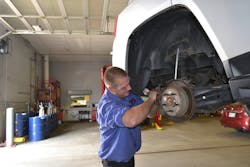When it comes to diagnosing brake, ride control and tire wear issues, a new approach to the tried-and-true steps for inspecting vehicles can help boost service sales and reduce comebacks. For details, Modern Tire Dealer turned to Joe Bacarella from Tenneco Inc., manufacturer of Monroe shocks and other aftermarket products, and Dann Ingebritson from Brake Parts Inc LLC (BPI), maker of Raybestos brand brakes.
Think dynamically
Since most inspections are performed when a vehicle is on a hoist or alignment rack, technicians fall into a pattern of thinking statically when performing inspections or alignments, according to Bacarella, who is Tenneco’s manager of training. The tendency is to think statically when diagnosing a ride, tire or braking concern, too.
“The most accurate brake, tire wear and ride control diagnosis comes from technicians who think dynamically. In other words, they are thinking about what’s happening when the vehicle, and specifically the suspension, is in motion,” says Bacarella.
“If they are looking at brakes statically, and not thinking about what’s happening to the suspension when they are applying the brakes, they are not going to resolve the brake issue.”
For example, technicians who think statically will recommend front brake service only for a vehicle with worn front brake pads and good rear pads. But technicians who think dynamically look at the vehicle’s repair history. They might find the customer has gone through front brake pads every 10,000 or 15,000 miles on a vehicle with 60,000 miles and the original rear brake pads.
Technicians who think dynamically consider what might cause brake pads to wear when the vehicle is in motion.
“For example, if there’s a lot of weight transfer to the front wheels, it could cause more loading on the front brakes and cause them to wear out prematurely,” says Bacarella. “If a technician inspects both front and rear ride control, he or she may discover the ride control components are worn, allowing the weight to transfer very quickly when the brakes are applied.”
Approaching the inspection with a dynamic mind-set also can prevent misdiagnosing the source of a customer’s complaint.
“Sometimes a customer will come in after a brake service and say the brakes feel grabby,” says Bacarella. “A tech may service the brakes again and try to resolve issues that could lead to grabby brakes. But when the tech drives the vehicle he or she may find it’s actually a weight transfer issue.”
“Every time they brake the front end might dive very quickly. The consumer thinks it’s caused by grabby brakes when worn ride control is causing the weight to shift very quickly.”
Tire cupping issues
Thinking dynamically helps determine the source of tire cupping issues, too. “Techs can align a vehicle and get everything perfect with the vehicle sitting statically, but if they are still experiencing an odd tire wear pattern, they need to think about what could cause that same type of wear even though all the alignment adjustments are fine,” says Bacarella.
In order to resolve the customer’s concern with the first repair, technicians need to focus on what is happening as the suspension moves through its travel. “Not just vertically, but as the steering turns left to right. That not only means dynamic toe changes, but also other dynamic alignment changes and how the ride control slows all those different things down.”
Ride control and tire vibration
Bacarella notes that worn ride control components can be a source of vibration issues with low-profile tires.
“If technicians do not have success eliminating a vibration through road force variation balancing, they might assume it’s coming from elsewhere in the vehicle, like the engine or the drivetrain. In reality the resolution could be to replace worn or low-cost replacement shocks and struts with premium units designed for the challenges presented by low-profile tires.”
The Monroe OE-Spectrum line of shocks and struts is engineered with the latest original equipment valving to help eliminate repetitive vibrations that are difficult to balance out of low-profile tires, according to Bacarella. The vibrations in properly balanced low-profile tires are due to the combination of lightweight suspension components made from materials like aluminum (instead of forged steel) and stiff sidewalls.
In older vehicles, tire cupping suggests worn ride control components. However, low-profile tires and lightweight suspension materials are reducing instances of tire cupping. “You don’t see tire cupping as often as you used to on older vehicles that had heavier suspension components. Issues with ride control wear are showing themselves as accelerated tire wear,” says Bacarella.
“The tire may not have the large cupped areas but may be wearing more quickly. Even more evidence would be vibrations in the vehicle that aren’t resolved even after the tires are balanced properly.”
Conversion kits
Bacarella says kits that convert high-tech ride control components on later-model vehicles to standard shocks and springs are becoming popular as vehicles age. Technologies such as electronic adjustable suspensions, air leveling systems and self-leveling mechanical shocks are expensive to replace.
“Sometimes tires are worn because the OE ride control components have failed and the customer doesn’t want to spend the money to replace the OE-style, high-end units. Monroe offers OE-style electronic replacement options as well as kits to convert the suspension to standard springs and premium aftermarket replacement units based on the customer’s needs.”
The conversion kits are easy to install, he says, and complete instructions for swapping the units are available at the Monroe website and YouTube channel. “Not only does the customer have new tires, but when the conversion kit is installed in place of worn units, the vehicle is more comfortable and stable, plus components will last longer since the suspension is restored to the proper height.”
OE versus replacement pads
Ingebritson, who is a senior trainer at Brake Parts, says an old saying used by tire dealers is easy for consumers to understand: “The brakes stop the tires from turning but the tires stop the car.” What customers don’t understand is why the replacement brakes don’t last as long as the original ones.
“In some cases, the aftermarket brake parts were not good quality and even under the perfect conditions, would not last or stop as well as the original equipment. But many times the replacement brake parts are the same or better quality than the OE,” he says.
If the replacement parts are better quality than the original, why don’t they last as long? “The answer is usually a combination of caliper operation, worn bushings, lack of lubrication and worn out shocks and struts. The nose dive and rear lift combine to put too much pressure on the front brakes.”
Most vehicles have dynamic rear proportioning (DRP), which uses the ABS (anti-lock braking system) and wheel speed sensors to control pressure to the rear wheels, says Ingebritson. A heavily loaded vehicle will have full brake pressure going to the rear calipers, if needed. Empty vehicles will have the pressure reduced using the isolation valve in the ABS unit.
The example of a loaded truck with lack of lubrication, worn tires, worn bushings, and worn shocks and struts pulling a trailer helps illustrate his point.
“Not only would the rear shocks allow the rear of the truck to lift, the trailer would make it worse. Now the driver is trying to stop with 80% front brakes and the tires keep locking up — remember they are almost bald — so the ABS keeps cycling. This all adds up to a bad experience trying to stop this truck quickly.”
Ingebritson says he would love to replace the pads and rotors on a brand new vehicle with Raybestos brakes. “Drive the vehicle until the pads wear down to sensors and record time and mileage. Now put on the pads and rotors that came with the vehicle and check time and mileage. I’d bet the tables would be turned and the OE parts would not last as long.”
3 systems working together
Electronic stability control (ESC), roll-over stability control (RSC) and auto emergency braking (AEB) all depend on the operation and condition of the brakes, tires and ride control.
“ESC actually applies one single brake to keep the vehicle on the road, without the driver touching the brake pedal,” says Ingebritson. “If the tire is bouncing off the road due to a pothole, the braking action will have no effect. It’s just like building a bridge. If the weakest support fails, they all fail and the bridge collapses.”
Ingebritson suggests service advisors and technicians think about how the brakes, tires and ride control work together and should be serviced together. For example, most vehicles go to the scrap yard with the OE shocks.
“People don’t notice the poor ride control because it creeps up over the years. They really notice when you replace ride control parts.”
Another example is a driver who runs tires down to the wear indicator, and the calipers are used over and over because they aren’t leaking.
“Calipers rely on the flex of the square cut seal to retract the piston,” says Ingebritson. “That seal starts to deteriorate around 50,000 miles. The caliper may not leak, but it can’t retract the piston, so the brakes wear out early.
“Educate your customer on these issues. You want them to have that ‘like new’ car feeling again and be safe while enjoying it.” ■




